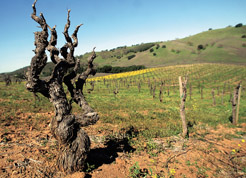Area vineyards feel the effects of last year’s frost,
drought
Last year’s early-spring frosts resulted in a
lighter-than-normal wine grape harvest in San Benito County and
throughout the state, but local vintners reported the wacky weather
didn’t affect the quality of their crop.
Area vineyards feel the effects of last year’s frost, drought
Last year’s early-spring frosts resulted in a lighter-than-normal wine grape harvest in San Benito County and throughout the state, but local vintners reported the wacky weather didn’t affect the quality of their crop.
“Last year was the biggest frost damage we’ve had in the 30 years of Calera being around,” said Mike Waller, assistant winemaker for Calera Wine Co. on Cienega Road south of Hollister. “There were probably seven or eight days of major frost damage from mid-April into May. Our yields were down.”
The winery’s Mills Vineyard produced approximately 1,100 cases in 2007, Waller said, compared with just half of that in 2008. Calera’s Selleck Vineyard, where it grows grapes for its highest-priced Pinot Noir, saw its yield drop from 17 barrels two years ago to just one barrel last year.
“In April, we’d start to see some bud break on the vines; then we’d get the freezing temperatures,” he said. “That can damage them so they don’t produce anything. We could still get a crop off the secondary buds” that sprouted.
Fortunately for local wineries, many of which can be found in the Cienega Valley, the rest of the growing season was “ideal,” Waller said.
“Consumers aren’t going to notice [a reduction] in quality,” he said. “We had a really great year as far as quality goes.”
The quantity produced, however, was another story.
San Benito County Agriculture Commissioner Paul Matulich said figures for 2008’s local wine grape harvest are not yet available. In 2007, San Benito County wineries produced more than $24 million worth of grapes on 3,800 acres. The average price per ton for locally-grown grapes was $1,180, Matulich said.
Just more than 3 million tons of wine grapes were crushed during last year’s harvest statewide, according to figures released by state agriculture officials. That was down approximately 6 percent from the year before. The drop in red wine production was sharper, down 9 percent.
Last year’s harvest was the third in a row with moderate to light yields following a bumper crop in 2005.
Pat DeRose, winemaker and vineyard manager at DeRose Vineyards, said last year’s frost “had a big impact on all of us across the state.”
“The cold weather was one issue, and depending on the varietals, some of the heat burned us at a different time,” he said. “Plus, our situation with the groundwater isn’t the best. There have been some pretty dry years recently and since we have some dry-farmed vines, not having rain affects us a lot.”
DeRose said his winery hasn’t yet bottled any of the ’08 crop, which still is in barrels.
“The wine appears to be very good,” he noted. “Just because you don’t have a lot of fruit doesn’t mean that you don’t have good wine.”
Sales of California wines throughout the United States slowed last year but still increased by 2 percent, with an estimated 196 million cases shipped. Sales in restaurants have softened, as retail consumers move toward cheaper bottles.
Waller said that not all Calera wines were affected by last year’s frost, as the winery does purchase “a lot of fruit” from elsewhere to produce some of its labels.
“All of our estate and Mt. Harlan wines were affected” because they use locally-grown grapes, Waller said. “The vines shouldn’t be too affected this year, though we haven’t seen any growth yet. As long as the frost doesn’t hit us this year, we should be able to bounce back from it.”
Despite a softening market for higher-end wines, The Wine Institute reports that U.S. wine exports were up 6 percent by value in 2008, passing the $1 billion mark for the first time. Winery exports also increased 8 percent by volume, according to the San Francisco-based institute, to nearly 130 million gallons or 55 million cases.
Institute president Robert P. Koch said the wineries have adjusted and remained competitive despite changes in U.S. dollar exchange rates and during strong and weak economic conditions.
Waller said Calera uses its distributors to “export a lot” in addition to sales through the winery and in local stores.
DeRose, which is known for its Zinfandel and “big-bodied red wines,” sells “quite a bit” of its wine locally, Pat DeRose said.
“We’ve seen that wine sales are still there, but we’re selling more of the wines that are mid-range. That’s been the biggest change,” he said. “People are buying the mid-range instead of the high-range wines.”
Sales of higher-priced wines have lagged industry-wide, “but while they’ve slowed down, sales of the $10 to $15 bottles have picked up,” De Rose said.
Despite weather and economic conditions, he said, “We make good wine and we try to keep the quality up – our quality hasn’t gone down.”
For more information on local wineries, go to the San Benito County Winegrowers’ Web site at www.sbcwinegrowers.org.
The Associated Press contributed to this report.










